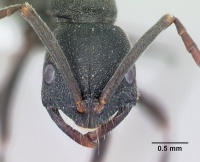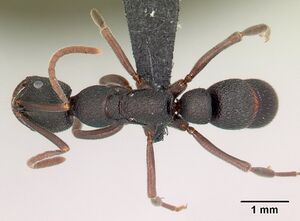Leptogenys tsingy
| Leptogenys tsingy | |
|---|---|

| |
| Scientific classification | |
| Kingdom: | Animalia |
| Phylum: | Arthropoda |
| Class: | Insecta |
| Order: | Hymenoptera |
| Family: | Formicidae |
| Subfamily: | Ponerinae |
| Tribe: | Ponerini |
| Genus: | Leptogenys |
| Species group: | truncatirostris |
| Species complex: | ridens |
| Species: | L. tsingy |
| Binomial name | |
| Leptogenys tsingy Rakotonirina & Fisher, 2014 | |
The species nests in rotten logs and dead branches above the ground, and forages in leaf litter.
Identification
A member of the ridens complex of the truncatirostris species group. Rakotonirina and Fisher (2014) - Worker. Clypeus with median carina, distance between anterior level of torulus and anteromedial clypeal margin greater than maximum width of scape; antennal scape relatively short; eye small, maximum diameter roughly one-fifth the length of sides of head, not extending beyond lateral cephalic border when head in full-face view; node broader than long (DNI: 134–146); dorsum of mesosoma, petiolar node and gaster with few short suberect hairs and dense pubescence; dense and fine sculpture; smaller species (HW: 1.20–1.34, HL: 1.42–1.56, WL: 2.17–2.39).
Leptogenys tsingy is very similar to Leptogenys namoroka, but the former has the petiolar node broader than long in dorsal view (DNI: 134–146), body sculpture much coarser, and more suberect hairs and sparse pubescence, whereas the latter has a much longer petiolar node (DNI: 115), finer body sculpture, fewer short, suberect hairs and abundant pubescence. Both species belong to the ridens species complex, together with Leptogenys ridens and Leptogenys fotsivava. As a consequence, L. tsingy can be confused with L. ridens and L. fotsivava, but L. ridens is characterized by a longer antennal scape and larger eyes and L. fotsivava has much larger eyes that break the outline of the sides of the head.
Keys including this Species
Distribution
The distribution of L. tsingy is limited to the dry forest habitats on Tsingy in the PN Tsingy de Bemaraha and PN Namoroka between 100 m and 150 m.
Latitudinal Distribution Pattern
Latitudinal Range: -18.7094° to -18.7094°.
| North Temperate |
North Subtropical |
Tropical | South Subtropical |
South Temperate |
- Source: AntMaps
Distribution based on Regional Taxon Lists
Malagasy Region: Madagascar (type locality).
Distribution based on AntMaps
Distribution based on AntWeb specimens
Check data from AntWeb
Countries Occupied
| Number of countries occupied by this species based on AntWiki Regional Taxon Lists. In general, fewer countries occupied indicates a narrower range, while more countries indicates a more widespread species. |

|
Estimated Abundance
| Relative abundance based on number of AntMaps records per species (this species within the purple bar). Fewer records (to the left) indicates a less abundant/encountered species while more records (to the right) indicates more abundant/encountered species. |

|
Biology
|
Castes
Worker
Images from AntWeb
   
| |
| Holotype of Leptogenys tsingy. Worker. Specimen code casent0493181. Photographer Jean Claude Rakotonirina, uploaded by California Academy of Sciences. | Owned by CAS, San Francisco, CA, USA. |
Nomenclature
The following information is derived from Barry Bolton's Online Catalogue of the Ants of the World.
- tsingy. Leptogenys tsingy Rakotonirina & Fisher, 2014: 154, figs. 17B, 18A, 167, 175 (w.) MADAGASCAR.
Unless otherwise noted the text for the remainder of this section is reported from the publication that includes the original description.
Description
Worker
(6 specimens). HW: 1.20–1.34, HL: 1.42–1.50, CI: 85–89, SL: 1.33–1.53, SI: 111–115, PW: 0.88–0.96, WL: 2.17–2.39, PNH: 0.82–0.90, PNL: 0.55–0.64, PNW: 0.78–0.86, DNI: 134–146, LNI: 134–150.
In full-face view, head roughly subquadrate, but slightly wider in front of level of eyes; sides meeting more or less concave posterior margin in a convex line. In full-face view, maximum eye diameter about one-fifth the length of lateral cephalic margin; eye location not interrupting lateral border of head in full-face view. Antennal scape relatively short, only one-fourth of distal portion reaching posterior cephalic border. In full-face view, anteromedial clypeal margin bordered by whitish lamella; length of median lobe of clypeus measured from anterior level of antennal insertion to anteromedial clypeal margin roughly greater than maximum width of scape. With head in full-face view and mandible fully closed, basal two-thirds of blades tightly closed against anterior margin of clypeus while distal thirds cross each other and apparently project downward in front of anteromedial clypeal margin. With mesosoma in dorsal view, metanotal groove distinct, marked by few transverse striae. In lateral view, posterolateral margin of propodeum without visible lobe. Petiolar node wider than long in dorsal view, with posterior margin straight and lateral margin broadly rounding to convex anterior margin. Mandible longitudinally striate, superimposed with scattered small punctures. Propodeal declivity with transverse rugulae. Body generally covered by coarse rugae with higher ridge, dorsum of head, mesosoma and petiolar node reticulate-rugulose interspersed by scattered foveoles or large punctures. Third and fourth abdominal tergites reticulate-rugulose but with denser and more elongate punctures. Dorsum of body covered by short and numerous standing hairs and sparse pubescence. Integument black to dark brown and appendages generally brown, tip of gaster and apical portion of appendages lighter in color.
Type Material
Holotype worker: Madagascar, Mahajanga, PN Tsingy de Bemaraha, 10.6 km ESE 123° Antsalova, -18.7094, 447182, 150 m, tropical dry forest on Tsingy, ex rotten log, 16–20 Nov 2001 (Fisher-Griswold Arthropod Team) collection code: BLF06538, specimen code: CASENT0493181 (California Academy of Sciences). Paratypes: 3 workers with the same data as holotype but specimen coded as CASENT0196369, CASENT0493182, CASENT0247215 (CASC, The Natural History Museum).
References
- Rakotonirina, J.C. & Fisher, B.L. 2014. Revision of the Malagasy ponerine ants of the genus Leptogenys Roger (Hymenoptera: Formicidae). Zootaxa 3836, 1-163.

